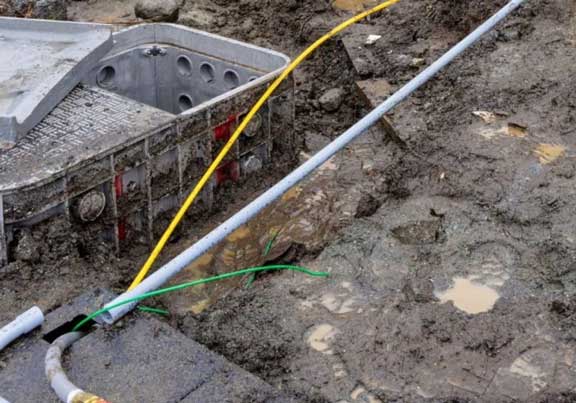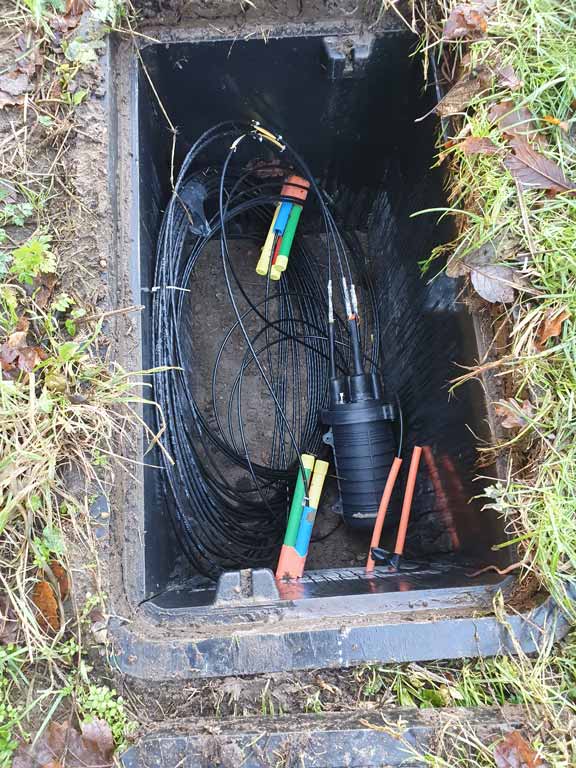Handholes are shallow chambers constructed inground to access telecom cables/components with your hands. Handholes also known as telecom vaults or joint pits, are necessary for a fiber optic network route along its length to access the cable at periodic intervals. The most commonly used handholes in the telecom industry are rectangular in shape. Sizes range from 12″ -12″ -12″ up to 48″ -60″ -48″. The 48-60-48 are capable of 576+ core fiber cables.

fiber handholes provide access to the underground duct or innerduct during cable installation and provide storage space for slack cable and splice closures. The fiber handhole must also be large enough to accommodate the cable’s minimum bend radius during installation as well as the installation tools and equipment that may be used during cable installation. In general, medium fiber handholes such as 30-48-36, and 24-36-36 are required to provide sufficient space for 288+ core backbone and splice closures. And 17-30-24 and 24-36-24 fiber handholes are ideal for 144+ core cables.
What is backbone cabling?
The optical fiber backbone is the most effective means of transmitting data. Fiber can transfer the highest bandwidth means less cable, fewer repeaters, less power consumption, and less maintenance. Cabinet backbone cabling is the most suitable means for large facilities and campuses such as large warehouses, data centers, schools, hospitals, warehouses, offices, and universities. Generally, 144-core and 288-core fiber cabinets are the common size of large backbone cabling for inter-building and intra-building. 12,24, and 48 core cabinets are considered to match the real demands of fiber network design.
In some cases, smaller handholes can be used at intermediate locations, but at a minimum, the intermediate handholes must be large enough to accommodate slack cable coils. If the intermediate handhole will be used for future splicing activities or as an intermediate assist location during cable installation, the intermediate handhole should be sized the same as the splice handholes. A common size for intermediate handhole is 17-30-24,12-18-18 inches.

In addition, consideration should be given to installing larger-sized handholes if additional cables and/or splice cases may be installed at a future date. Innerducts should enter the handhole near the corners so that the full width of the handhole can be used to coil the cable. Before cable installation, the inner ducts should be trimmed as necessary to accommodate cable placement. After cable installation, the inner duct should be trimmed so that only about six inches of inner duct protrudes into the handhole.
Handholes are available in a variety of shapes, sizes, and materials, and for different vehicle loading conditions. In addition to selecting properly sized handholes, it is the responsibility of the outside plant engineer to consider local, state, and federal requirements that may influence the appropriate handhole choice.
The minimum bend diameters for fiber cables are defined for both dynamic and static conditions. The dynamic condition applies during installation. Caution must be used when pulling the cable out of the handhole to avoid bending the cable below its minimum required bend diameter. Some cable manufacturers specify minimum bend radius rather than minimum bend diameter. The minimum bend diameter can be converted to the maximum bend radius by dividing the minimum bend diameter by two.
Splice Handholes: Slack cable must be stored at splice locations to allow for splicing. Typically, a cable length of 50 to 100 feet is required for splicing purposes; however, the actual cable length may vary depending on the accessibility of the handhole. To eliminate the twist, the slack cable should be rolled into a storage coil as the cable supplier described.
Contact Us Today
Pacing Fiber Optic Cable in underground handholes or pull boxes. Cable storage coils must meet the minimum bend diameter requirements. Intermediate Handholes: Many end users require that slack cable be stored in intermediate handholes along the cable route. These slack storage coils are used for future branch splices or route rearrangements. It is important that the coiling method accommodates the proper coil diameter. FiberKnct is a technology designer, manufacturer, and supplier of high-quality outside plants and cable anchoring products, fiber optic handholes , fiber pedestals. FiberKnct offers innovative product solutions, such as the fiber optic cabinets, surface box line of splice closures and accessories, The reliability of FiberKnct’s complete line of fiber optic, copper, demarcation, bonding, and cabling solutions combined with the company’s knowledgeable sales, customer service, and technical support teams truly make FiberKnct the connection you can count on.Contact us today if you need assistance or share a opinioon with selecting any Outside Plant Products.
